The race for AI search platforms is heating up. Perplexity, an AI-driven search platform developed by Brightedge, released a study on how Perplexity compares to Google’s SGE and how these AI-first search platforms differentiate themselves. While the battle for users across these new platforms is still early, how brands can prepare for AI search visibility is backed by longstanding fundamentals.
AI-first engines are steadily gaining ground and carving out their own areas of expertise, making it critical for the marketing community to master multiple search platforms.
Two Search Fundamentals to Master in the Age of AI Platforms
1. Focus on Key Areas of Expertise
Since the early 2010s, a content strategy methodology called Content Siloing has helped brand sites elevate topic relevance, depth, and expertise to search platforms and customers. Now better known as Topic Clustering, the elements of building a solid content foundation to achieve valuable visibility remain the same.
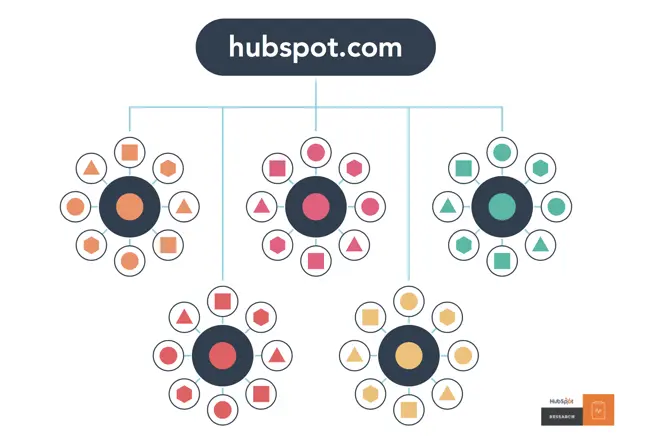
Prioritize for Clarity & Focus
This is always the most challenging step for brands, which is often why sites turn into lengthy, static menus rather than dynamic, focused experiences. Aligning internal stakeholders on a handful of key priority areas of the business requires a mix of reflection, negotiation, and bravery. Pierre Herubel’s visuals below show how core business fundamentals are central to marketing success or failure. We recently wrote an article about how bad marketing is often the canary in the coal mine of unfocused business priorities, and nimble strategic planning is essential to clarity and a deep understanding of your core business offerings.
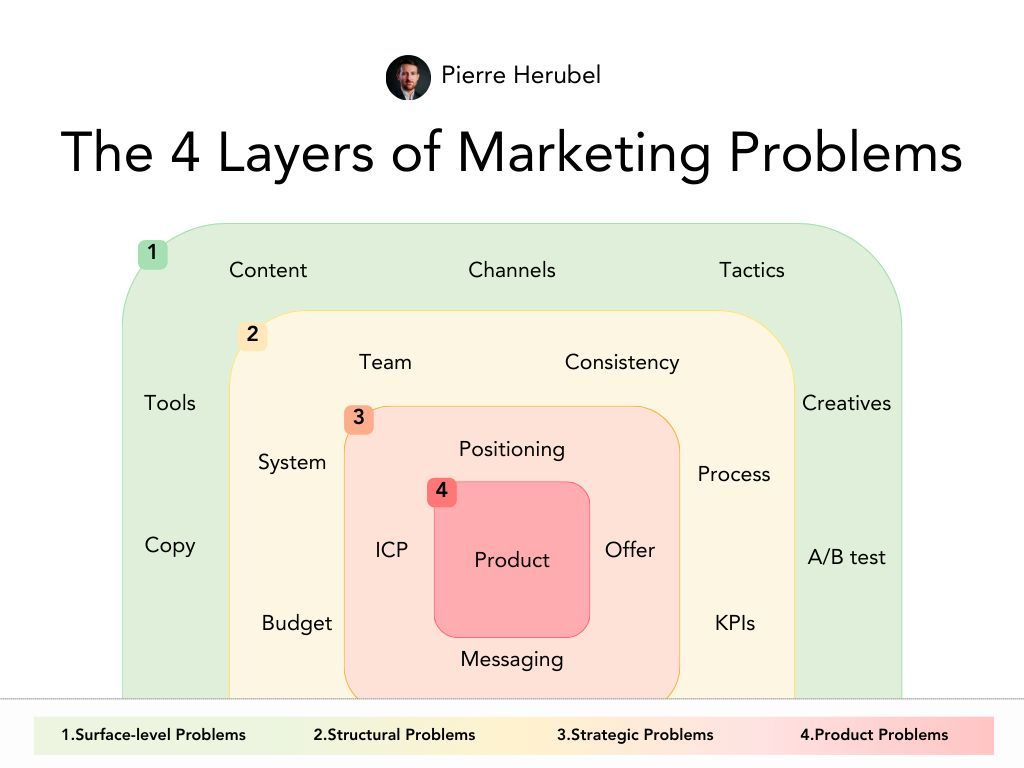
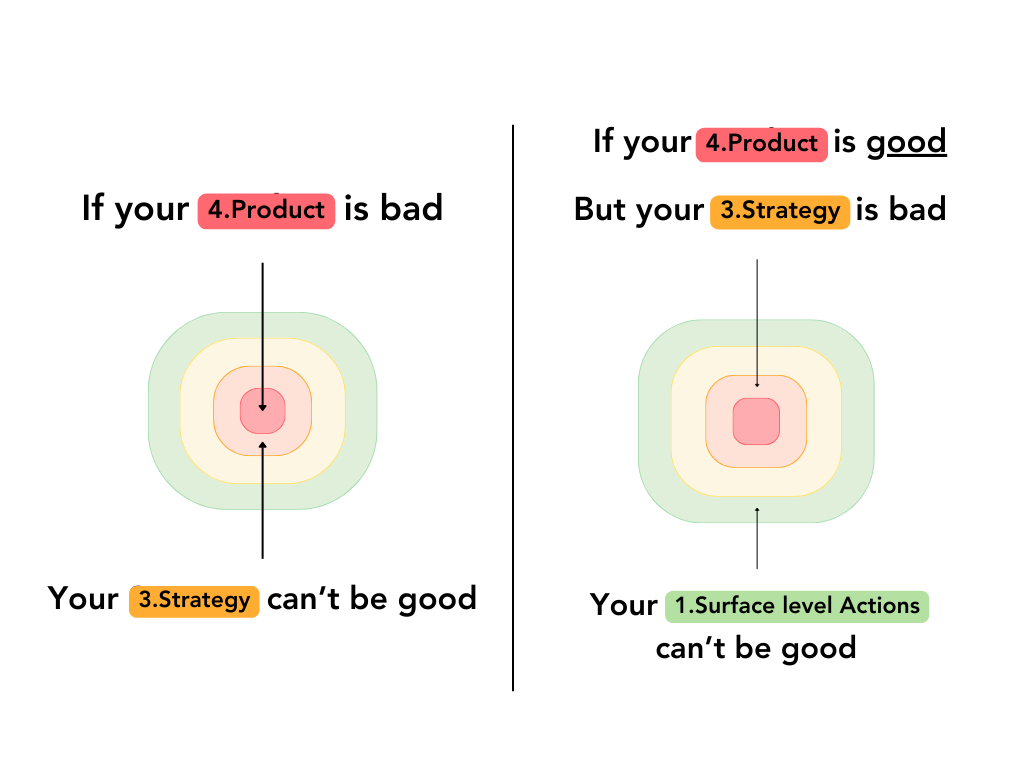
Build for Experiences, Not Keywords
An audience segment that makes sense for one area of expertise may not make sense in another. Avoid backing assumed audiences into narrow messaging funnels. How? Leverage holistic audience insights to inform experience gaps and opportunities within each of your areas of expertise.
I think individual, made-up personas of “Marty the Map Enthusiast” or “Rena the Real Estate Agent” are generally worse than useless. What you really want is verifiable, actionable data, at scale, about hundreds or thousands of people who match your ideal customer profiles.
Unpack Current Audience Expectations and Anticipate Future Needs
ICPs: Ideal Customer Profiles help benchmark the business characteristics of your existing customers (not specific customers). Leverage qualitative data formats like surveys, interviews, and CRM data to understand better the ICPs most relevant to your areas of expertise.
Personas: When building out personas, look beyond a narrow, fictional buyer profile. Leverage historical, real-time, and predictive data across owned and third-party sources to unpack holistic insights for a subset of customers, influencers, decision-makers, and more. Use tools like Google Analytics, Google Ads, CRMs, HotJar, SparkToro, and SEMRush.
Digital Behaviors & Preferences: Leverage tools like SparkToro to better understand real-time, contextual conversations and interests for your audiences. We particularly like SparkToro because the platform layers what is searched with who is searching and their behaviors beyond the SERP. These contextual insights help marketers build multichannel hubs and spokes within their topic cluster frameworks.
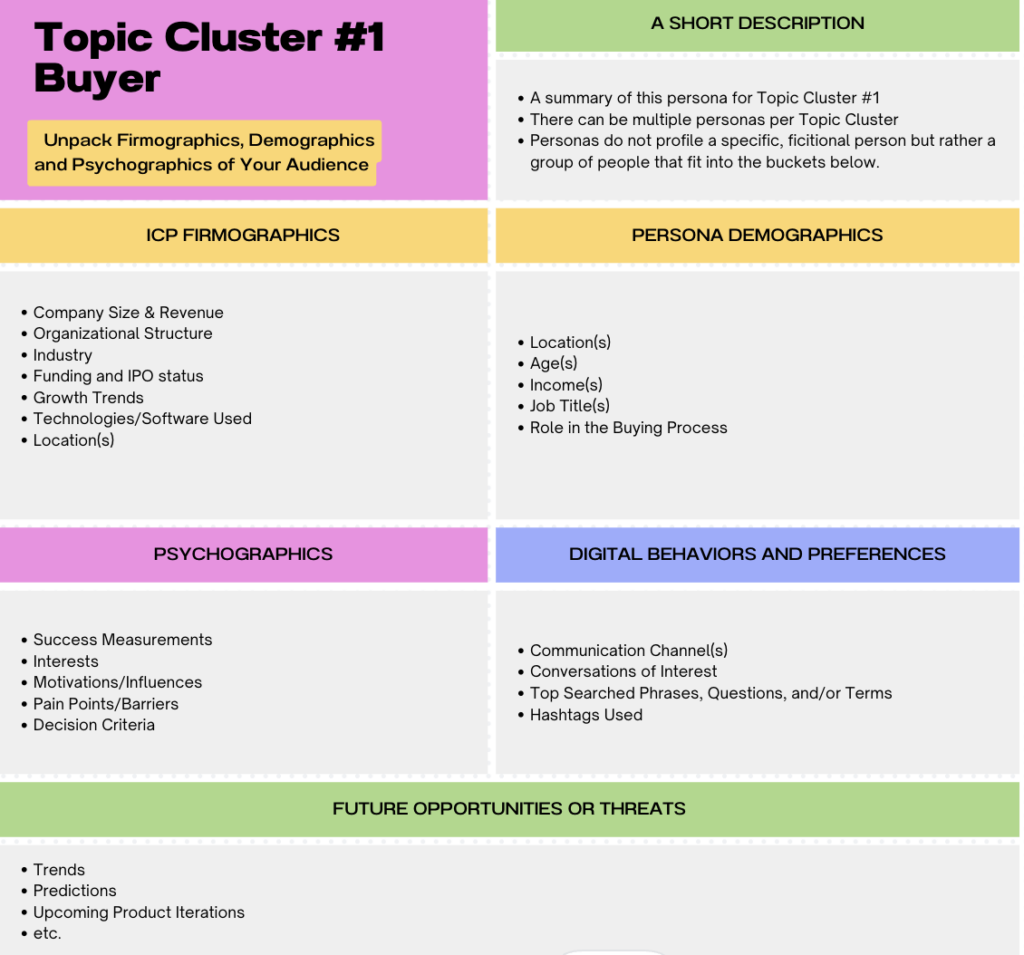
Benchmark Existing Experiences With a Content Audit
Assess your experiences around each topic cluster to better understand the type of content your teams have already developed and potential gaps based on your audience research. For example, if you’re a fintech company and one of your topic cluster focus areas is Crypto, you’ll want to crawl your existing site to evaluate all pages, images, videos, etc., focusing on Crypto messaging. We recommend leveraging tools like ScreamingFrog to crawl your site and tools like Google Analytics, Google Search Console, CRMs, and SEMRush to assess historical performance data.
The purpose of a content audit is to:
- Document a comprehensive, topic-focused list of crawlable and indexable content across your owned channels (website, YouTube, etc.) that can be repurposed, condensed, or removed.
- Type of Content (Blog Article, Case Study, Service Page, Product Listing Page, Product Detail Page, Video, etc.)
- Headers & Meta Data
- Schema
- Links (Internal and External)
- SERP Rankings & Visibility
- Analyze the performance of existing topic-focused content to understand better if they are attributing to defined OKRs.
- Sales/Revenue
- Events (Macro and Micro)
- Conversion Rates
- Assess if the existing content engages key audiences across journey stages as anticipated based on the journey maps you’ve built in advance.
- Channel Attribution
- Intent Stage
- Engagement Metrics (Page Engagement, Shares, etc.)
- Device
Once you export your crawl and organize performance measurements, you can leverage AI tools like GPT and others to speed up your scoring process and better understand what’s working and not working and where the most significant opportunities lie. We recommend checking out this video by Seer Interactive as an example of how to score your content with AI assitants.
Develop Your Content Strategy
It’s time to put your findings into a concise document that clearly outlines your planned topic cluster outcomes and prioritizes the execution plan based on impact and effort. Below is an example of what this could look like. Remember that identifying and resolving internal marketing system bottlenecks is critical to your content strategy’s success.
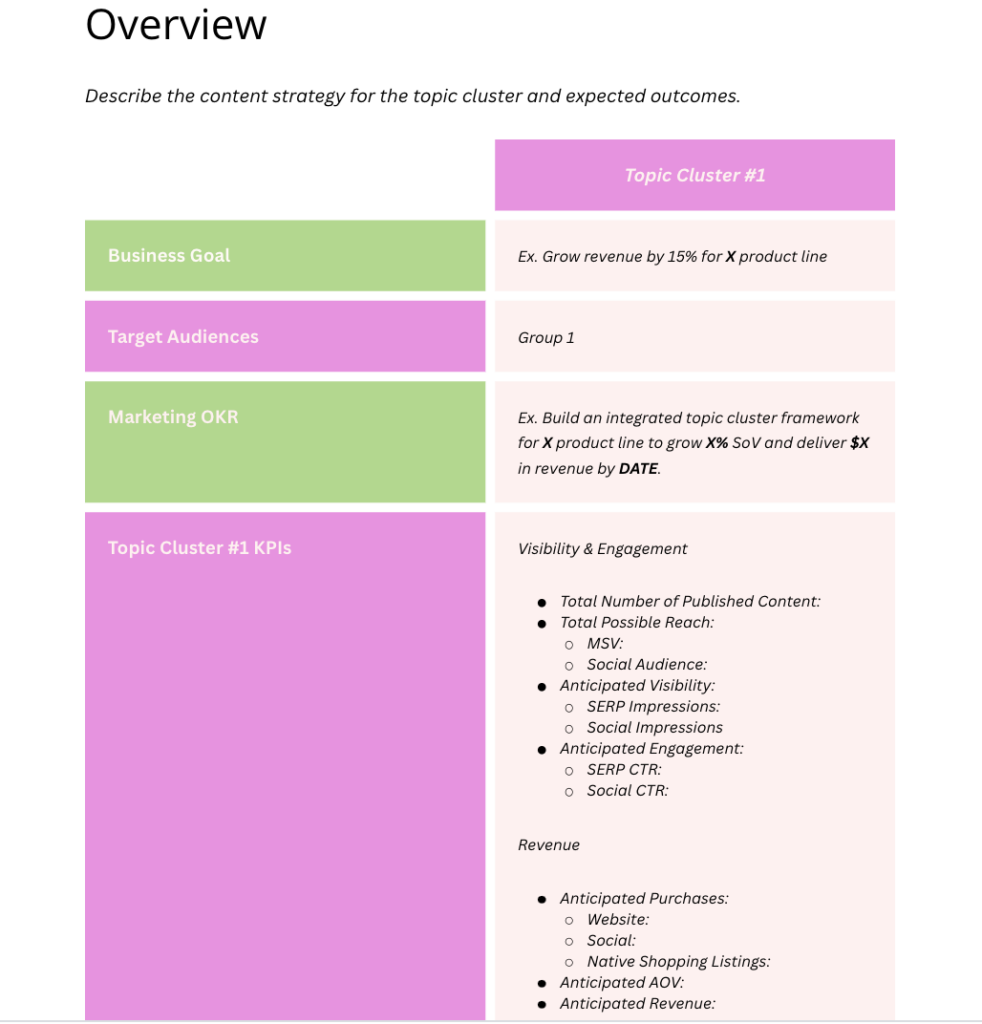
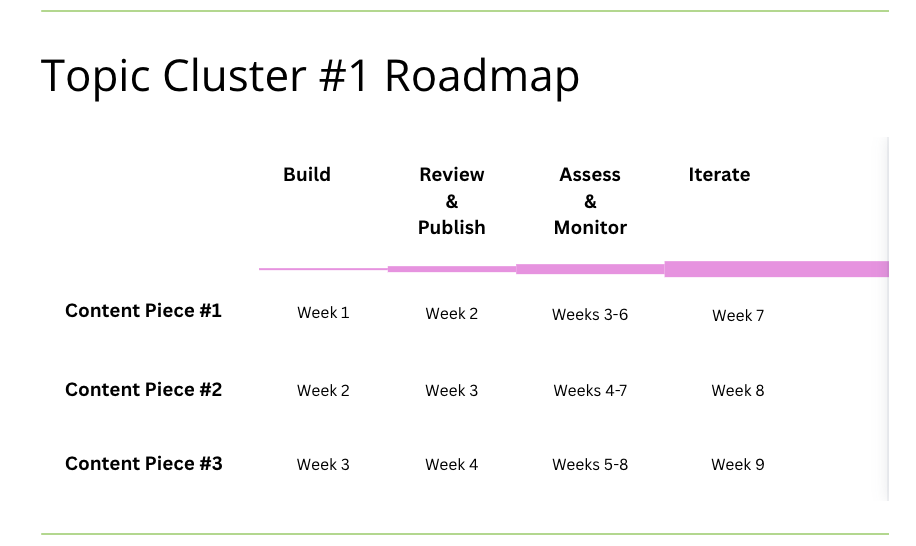
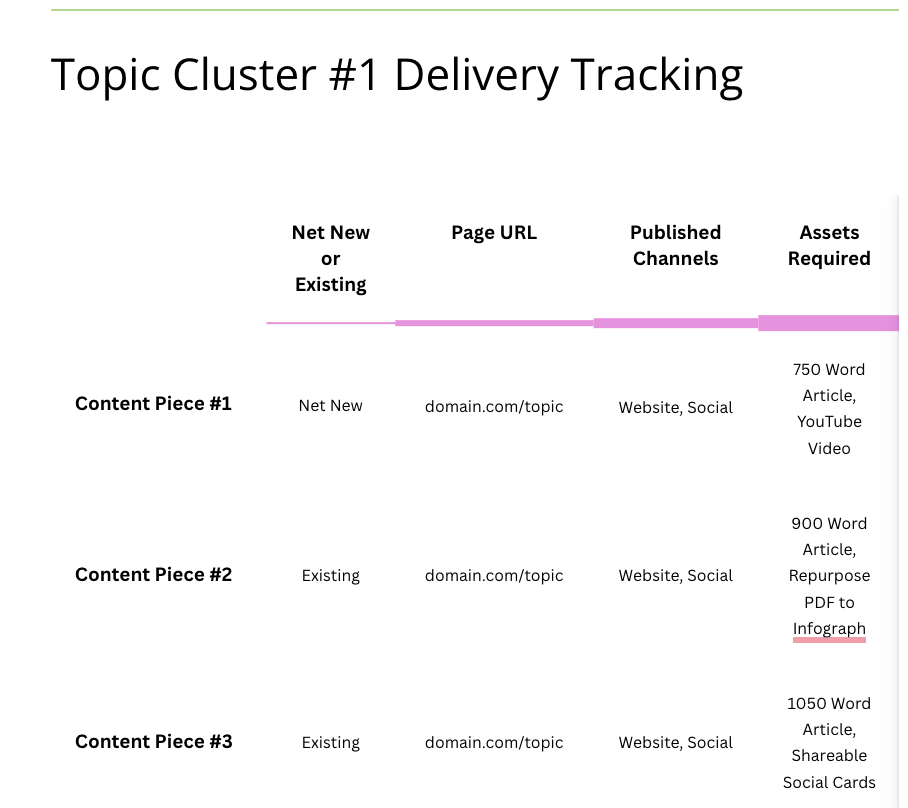
2. Elevate Contextual Enhancements With Structured Data
At its core, the purpose of structured data is to improve the organization, accessibility, and relevance of information through standardized markup. Google introduced Rich Snippets in 2009, leveraging structured data markup to enhance search results with additional information such as reviews, ratings, and event details. In 2011, major search engines, including Google, Bing, Yahoo, and Yandex, collaborated to create Schema.org, a unified vocabulary for structured data markup. The Knowledge Graph, launched by Google in 2012, relies on structured data and semantic search techniques to provide users with direct answers and contextual information in search results. Over the last twelve years, Schema.org has expanded to cover various content types and industries, including local businesses, recipes, movies, and more.
Today, with advancements in AI search platforms, structured data plays a crucial role in semantic search and enables crawlers to interpret the meaning and relationships within content to deliver more relevant results to audiences in diverse and native formats.
Because Gemini 1.5 Pro is multilingual — and multimodal in the sense that it’s able to understand images and videos and, as of Tuesday, audio streams in addition to text — the model can also analyze and compare content in media like TV shows, movies, radio broadcasts, conference call recordings and more across different languages.
TechCrunch, Google’s Gemini Pro 1.5 enters public preview on Vertex AI
Top Five Reasons Structured Data is Critical for AI-Powered Search Visibility
- Enhanced Entity Recognition: Structured data uses standardized vocabularies to explicitly define the entities on your pages (people, products, organizations, events, etc.). AI-powered search engines can easily recognize these entities and understand the relationships between them. This improved entity understanding allows AI to match your content to more complex and nuanced search queries.
- Personalization and Contextualization: AI search systems learn from user behavior and past searches. Structured data provides them with clear signals to understand user preferences and the context of a search. This allows AI to tailor search results to the individual user, increasing the chances your content will surface when it’s most relevant.
- Improved Semantic Understanding: Structured data adds a layer of semantic meaning to your content. It goes beyond keywords to define how concepts and entities relate to each other. AI search engines use this semantic understanding to provide more relevant and comprehensive results, potentially surfacing your content even for indirectly related queries.
- Enabling Natural Language Search: Structured data allows machines to understand your content the way humans do. This is essential for conversational AI search systems. AI search engines can use structured data to interpret natural language questions and pinpoint the most relevant information within your content.
- Supporting Knowledge Graphs: Structured data feeds into the creation of vast knowledge graphs that AI search algorithms rely on. Knowledge graphs connect related entities, facts, and concepts in a massive information. By contributing your structured data to this knowledge graph, your content gains potential visibility across a broader range of AI-powered search experiences.
Summary
As competition continues to thrive around AI-powered search platforms, it’s essential not to overlook what has always been fundamental to enhancing the visibility of your content. Topic clustering your content provides focused, in-depth, and semantically linked content that is well-suited to how your audiences search and AI analyzes information. Structured data adds machine-readable clarity to this content. This combination leads to:
- Higher Relevance in Search Results: AI search can accurately match your content to the intent of a user’s query.
- Increased Visibility: Get noticed with rich snippets and other search result enhancements.
- Improved User Experience: Provide a seamless experience that meets your audience where they are along their journey.
Did you find this article interesting? Don’t forget to share.
Keep up with more evolving search trends by following us on LinkedIn.
How To Reshape Your Marketing Program
We recently performed a marketing gap analysis for a client. The goal was to understand…



